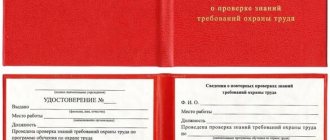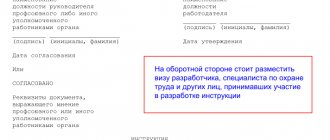Job description of a labor protection specialist
[name of company]
This job description was developed and approved in accordance with the provisions of the Labor Code of the Russian Federation, Order of the Ministry of Health and Social Development of the Russian Federation dated May 17, 2012 N 559n “On approval of the Unified Qualification Directory of positions of managers, specialists and employees, section “Qualification characteristics of positions of managers and specialists carrying out work in the field of labor protection” and other legal acts regulating labor relations.
Exercising control
But the work of this engineer is not limited to this. Most of it consists of carrying out comprehensive control measures in the field of safety of the enterprise’s activities, as the standard job description tells us. The occupational safety specialist is required to monitor the following points:
- to what extent are labor safety measures prescribed in collective agreements, labor protection agreements, and others aimed at creating safe and healthy working conditions implemented;
- Are safety instructions available in each department?
- whether tests and technical examinations of production equipment were carried out on time;
- whether the aspiration and ventilation systems, safety and protective devices of the mechanisms function effectively;
- Are annual scheduled inspections of the grounding of electrical installations and electrical wiring insulation carried out?
- whether workers are provided with the required special clothing and footwear, what condition they are in, whether they are cleaned, washed and repaired in a timely manner.
https://youtu.be/ZTFdT8ru5d8
General provisions
1.1. An occupational safety specialist belongs to the category of specialists and is directly subordinate to [name of the manager's position].
1.2. An occupational safety specialist is appointed to a position and dismissed from it by order of [name of position].
1.3. A person who has a higher professional education in the field of training “Technosphere Safety” or corresponding areas of training (specialties) in ensuring the safety of production activities or higher professional education and additional professional education (professional retraining) in the field of labor protection without presenting requirements for work experience, or secondary vocational education and additional vocational education (professional retraining) in the field of labor protection, work experience in the field of labor protection of at least 3 years.
1.4. The occupational safety specialist must know:
— laws and other regulatory legal acts in the field of labor protection;
— state regulatory requirements for labor protection;
— international treaties in the field of labor protection, ratified by the Russian Federation;
— national and interstate standards in the field of occupational safety and health;
— labor protection requirements established by labor protection rules and instructions;
— office work and methodological documents on labor protection issues;
— methods for identifying, assessing and managing professional risks;
— production and organizational structure of the organization, basic technological processes and production modes;
— types of equipment used and rules of its operation;
— methods for studying working conditions in the workplace;
— psychophysiological requirements for employees;
— rules and means of monitoring compliance of the technical condition of equipment with the requirements for safe work;
— procedure for conducting accident investigations;
— advanced domestic and foreign experience in the field of labor protection;
— the procedure and timing of reporting on the implementation of labor protection measures;
— basics of labor legislation;
— internal labor regulations;
— rules of sanitary and personal hygiene;
— rules and regulations of labor protection, safety and fire protection.
Who can become a security engineer in an organization: education and experience
The most favorable situation would be to employ an employee with a specialized education, for example, “Process Safety” or in related areas of study, as an occupational safety engineer. This is especially important for enterprises where professional work conditions are truly dangerous.
The functions of such an engineer are often performed by employees who do not have a specialized education , but have undergone professional retraining or advanced training courses. Moreover, if the employer has hazardous production facilities at his workplace, the specialist must undergo appropriate training in each of them.
In some cases, requirements are imposed on the professional experience of a specialist , for example, for admission to hazardous facilities, qualification level 7 is required, which, in addition to special education, requires at least 5 years of work experience in the relevant field. In most cases, a higher education or secondary specialized education combined with 3 years of experience (qualification level 6) is sufficient.
Job responsibilities
The occupational safety specialist is assigned the following job responsibilities:
2.1. Participation in the organization and coordination of labor protection work in the organization.
2.2. Participation in the development and monitoring of the functioning of the occupational safety management system in the organization in accordance with state regulatory requirements for occupational safety, with the goals and objectives of the organization, recommendations of interstate and national standards in the field of occupational safety and health.
2.3. Participation in determining and adjusting the direction of development of the occupational risk management system in the organization based on monitoring changes in legislation and best practices in the field of labor protection, as well as based on the modernization of technical equipment, goals and objectives of the organization.
2.4. Monitoring compliance in the structural divisions of the organization with legislative and regulatory legal acts on labor protection, carrying out preventive work to prevent industrial injuries and occupational diseases, implementing measures aimed at creating healthy and safe working conditions in the organization, providing employees with established compensation for working conditions.
2.5. Informing employees about the state of labor conditions and labor protection in the workplace, existing professional risks, compensation due to employees for hard work, work in harmful and (or) dangerous working conditions and other special working conditions and personal protective equipment, as well as about protective measures workers from exposure to hazardous and harmful production factors.
2.6. Monitoring the timeliness and completeness of provision of employees of the organization with special clothing, special footwear and other personal protective equipment, therapeutic and preventive nutrition, milk and other equivalent food products.
2.7. Monitoring the condition and serviceability of individual and collective protective equipment.
2.8. Identifying the need for training of workers in the field of labor protection based on state regulatory requirements for labor protection, as well as labor protection requirements established by the rules and instructions on labor protection, conducting introductory briefings, monitoring the conduct of briefings (initial, repeated, unscheduled, targeted) of employees on labor protection issues.
2.9. Participation in monitoring the execution of the organization’s budget in the field of labor protection and assessing the effectiveness of the use of financial resources in terms of achieving the set goals and objectives.
2.10. Development of proposals to increase the effectiveness of measures to improve working conditions and labor protection.
2.11. Monitoring the targeted use of funds for the implementation of measures to improve working conditions and safety.
2.12. Participation in the work of the commission for conducting a special assessment of working conditions, organizing the interaction of members of the commission for conducting a special assessment of working conditions, created in the organization in the prescribed manner.
2.13. Participation in the development of sections of the collective agreement regarding the preparation of measures to improve conditions and labor protection in the organization, as well as the rights and obligations of employees and the organization’s management in the field of compliance with labor protection requirements, monitoring the work on the preparation of proposals from the structural divisions of the organization for inclusion in the action plan to improve working conditions and safety.
2.14. Organization and participation in the work to determine the contingent of workers subject to mandatory preliminary upon hiring and periodic medical examinations, pre-trip (post-trip) and pre-shift (post-shift) examinations.
2.15. Providing methodological assistance to the heads of structural divisions of the organization in the development of new and revision of existing labor protection instructions, as well as in the preparation of training programs for workers in safe techniques and work methods.
2.16. Organization of work on the preparation of technical specifications for the provision of services in the field of labor protection, the supply of personal and collective protective equipment, as well as the assessment of proposals received from suppliers of individual and collective protective equipment for their supply.
2.17. Conducting an analysis of the organizational structure, technical equipment of the organization, state regulatory requirements for labor protection, advanced domestic and foreign experience in the field of labor protection.
2.18. Participation in the investigation of industrial accidents and occupational diseases, analysis of the causes of industrial injuries, occupational diseases, and in the development of measures to prevent them.
2.19. Participation in the development of measures to increase the level of employee interest in improving labor conditions and safety.
2.20. Together with other structural divisions of the organization, participation in the development of plans and programs to improve working conditions and safety, eliminate or minimize occupational risks.
2.21. Monitoring compliance with labor protection requirements, safe techniques and work methods during internships for students in institutions of secondary and higher vocational education and labor training for schoolchildren.
2.22. Drawing up and submitting a report in the prescribed form.
2.23. [Other job responsibilities].
Order on distribution of responsibilities
In general, the issue of organizing safe conditions for the professional activities of personnel at an enterprise is within the exclusive competence of the employer. The main list of employer responsibilities in the field of labor protection is set out in Article 212 of the Labor Code of the Russian Federation. The General Director can independently deal with these issues, including assuming the responsibilities of the person responsible for labor safety during a fire. However, this approach is unlikely to have a positive result: the amount of work is too large, or the activity of the enterprise as a whole will suffer, or the safety of production processes will not be good. Therefore, it is advisable to take a reasonable and balanced approach to the distribution of these responsibilities, especially since no one relieves the owners and top officials of enterprises of responsibility, even if they fully delegate their responsibilities to subordinate officials.
The delegation of powers is formalized by an order on the distribution of responsibilities for labor protection and the creation of the position of a labor protection specialist (if the staffing level of the enterprise exceeds 50 units, this must be done without fail (Article 217 of the Labor Code of the Russian Federation).
Since the employer does not have the physical ability to be at each workplace at the same time (and by law he ensures safe conditions at the enterprise in general, that is, everywhere), the organization issues an order assigning labor protection responsibilities to responsible officials (drawn up in a free form).
Sample order on the distribution of labor protection responsibilities
The meaning of this document is that the employer retains the function of organizing safe conditions in the enterprise as a whole, and designated responsible persons on site ensure control over the fulfillment by employees of duties in the field of safety of their professional activities, of which workers do not have many (Article 214 of the Labor Code RF):
- observe and implement labor safety regulations;
- correctly apply (use) personal and collective protective equipment;
- do not shy away from training in the field of labor protection (this includes briefings, internships, knowledge testing, etc.);
- do not hush up incidents, inform the employer about any situation that may (even theoretically) threaten the life and health of workers (if an accident occurs, an employee who did not report a possible danger, in a negative combination of circumstances, may be jointly and severally liable along with the employer , including criminal);
- undergo medical examinations.
Thus, designated responsible persons monitor employees’ compliance with legal requirements for life safety, and the employer provides appropriate conditions for them.
Rights
A labor protection specialist has the right:
3.1. For all social guarantees provided for by the legislation of the Russian Federation.
3.2. Receive information about the activities of the organization necessary to perform job duties from all departments directly or through the immediate supervisor.
3.3. Submit proposals to management to improve your work and the work of the organization.
3.4. Get acquainted with draft orders of management relating to its activities.
3.5. Sign and endorse documents within your competence.
3.6. Take part in meetings where issues related to his work are discussed.
3.7. Require management to create normal conditions for performing job duties.
3.8. Improve your professional qualifications.
3.9. [Other rights provided for by the labor legislation of the Russian Federation].
What the law says about official instructions in the field of occupational safety
Russian legislation establishes quite serious rules regarding the content of employee instructions on labor protection. Any such instructions are developed on the basis of the Labor Code, as well as Professional Standard 40.054.
If the employer has hazardous production facilities at his workplace, the specialist must undergo appropriate training for each of them.








